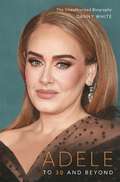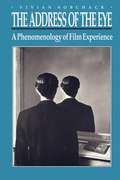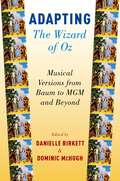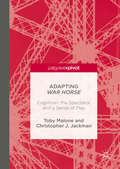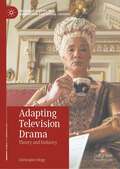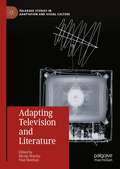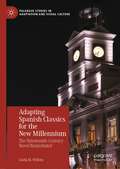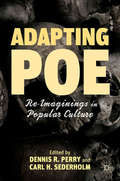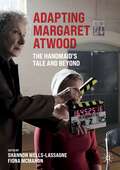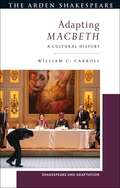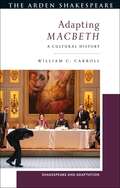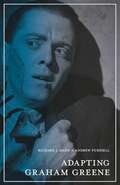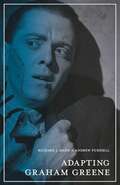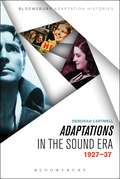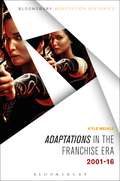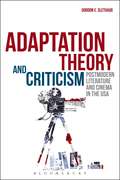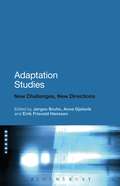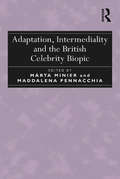- Table View
- List View
Adele: To 30 and Beyond: The Unauthorized Biography
by Danny White120 million records sold. The world’s biggest selling album of the twenty-first century. Countless awards and accolades. Adele has captured the hearts of millions and this intimate biography tells the astonishing journey of the Queen of Pop.The trademark authenticity of Adele’s songs has been hard earned: she was raised by a single mother and has been tested by bereavements and a string of break-ups. Just when she seemed to have left the pain behind, a harrowing divorce and a career-threatening throat injury brought new darkness and doubt to her doorstep. This book takes you behind the scenes of her highs, her lows and everything in between. Separating the myths from the truth, it examines the real Adele: a shrewd and ambitious star who approaches her career with an iconic blend of tradition and innovation. The superstar is back in the spotlight with a new album and a fresh look. But will Adele ever find happiness, or will she always be followed by what she calls her ‘very dark side’?
The Address of the Eye: A Phenomenology of Film Experience
by Vivian SobchackCinema is a sensuous object, but in our presence it becomes also a sensing, sensual, sense-making subject. Thus argues Vivian Sobchack as she challenges basic assumptions of current film theory that reduce film to an object of vision and the spectator to a victim of a deterministic cinematic apparatus. Maintaining that these premises ignore the material and cultural-historical situations of both the spectator and the film, the author makes the radical proposal that the cinematic experience depends on two "viewers" viewing: the spectator and the film, each existing as both subject and object of vision. Drawing on existential and semiotic phenomenology, and particularly on the work of Merleau-Ponty, Sobchack shows how the film experience provides empirical insight into the reversible, dialectical, and signifying nature of that embodied vision we each live daily as both "mine" and "another's." In this attempt to account for cinematic intelligibility and signification, the author explores the possibility of human choice and expressive freedom within the bounds of history and culture.
The Address of the Eye: A Phenomenology of Film Experience
by Vivian SobchackCinema is a sensuous object, but in our presence it becomes also a sensing, sensual, sense-making subject. Thus argues Vivian Sobchack as she challenges basic assumptions of current film theory that reduce film to an object of vision and the spectator to a victim of a deterministic cinematic apparatus. Maintaining that these premises ignore the material and cultural-historical situations of both the spectator and the film, the author makes the radical proposal that the cinematic experience depends on two "viewers" viewing: the spectator and the film, each existing as both subject and object of vision. Drawing on existential and semiotic phenomenology, and particularly on the work of Merleau-Ponty, Sobchack shows how the film experience provides empirical insight into the reversible, dialectical, and signifying nature of that embodied vision we each live daily as both "mine" and "another's." In this attempt to account for cinematic intelligibility and signification, the author explores the possibility of human choice and expressive freedom within the bounds of history and culture.
The Address of the Eye: A Phenomenology of Film Experience
by Vivian SobchackCinema is a sensuous object, but in our presence it becomes also a sensing, sensual, sense-making subject. Thus argues Vivian Sobchack as she challenges basic assumptions of current film theory that reduce film to an object of vision and the spectator to a victim of a deterministic cinematic apparatus. Maintaining that these premises ignore the material and cultural-historical situations of both the spectator and the film, the author makes the radical proposal that the cinematic experience depends on two "viewers" viewing: the spectator and the film, each existing as both subject and object of vision. Drawing on existential and semiotic phenomenology, and particularly on the work of Merleau-Ponty, Sobchack shows how the film experience provides empirical insight into the reversible, dialectical, and signifying nature of that embodied vision we each live daily as both "mine" and "another's." In this attempt to account for cinematic intelligibility and signification, the author explores the possibility of human choice and expressive freedom within the bounds of history and culture.
ADAPTING WIZARD OF OZ C: Musical Versions from Baum to MGM and Beyond
by Danielle Birkett and Dominic McHughOne of the most beloved film musicals of all time, The Wizard of Oz represents an enduring family favorite and cultural classic. Yet there is much more to the story than meets the eye, and the MGM movie is just one of many ways in which it has been represented. In this lively and wide-ranging book, editors Danielle Birkett and Dominic McHugh bring together insights from eleven experts into the varied musical forms this great American myth has taken in the past century. Starting with the early adaptations of L. Frank Baum's story, the book also explores the writing, composition and reception of the MGM film, its importance in queer culture, stage adaptations of the movie, cult classic The Wiz, Stephen Schwartz's Broadway blockbuster Wicked, and the cultural afterlife of the iconic Arlen-Harburg songs. What emerges is a vivid overview of how music - on stage and screen - has been an essential part of the story's journey to become a centerpiece of American culture.
Adapting The Wizard of Oz: Musical Versions from Baum to MGM and Beyond
One of the most beloved film musicals of all time, The Wizard of Oz represents an enduring family favorite and cultural classic. Yet there is much more to the story than meets the eye, and the MGM movie is just one of many ways in which it has been represented. In this lively and wide-ranging book, editors Danielle Birkett and Dominic McHugh bring together insights from eleven experts into the varied musical forms this great American myth has taken in the past century. Starting with the early adaptations of L. Frank Baum's story, the book also explores the writing, composition and reception of the MGM film, its importance in queer culture, stage adaptations of the movie, cult classic The Wiz, Stephen Schwartz's Broadway blockbuster Wicked, and the cultural afterlife of the iconic Arlen-Harburg songs. What emerges is a vivid overview of how music - on stage and screen - has been an essential part of the story's journey to become a centerpiece of American culture.
Adapting War Horse: Cognition, the Spectator, and a Sense of Play
by Toby Malone Christopher J. JackmanThis book analyses the success and adaptation of Michael Morpurgo’s novel War Horse to stage, radio, live events, and feature film, in different cultures, on tours, and in translation. In under a decade, War Horse has gone from obscure children’s novel to arguably one of the world’s most recognisable theatrical brands, thanks to innovative puppet designs from South Africa’s Handspring Puppet Company in an acclaimed stage production from the National Theatre of Great Britain. With emphasis on embodied spectatorship, collaborative meaning-making, and imaginative ‘play,’ this book generates fresh insights into the enduring popularity of the franchise’s eponymous protagonist, Joey, offering the most in-depth study of War Horse to date.
Adapting Television Drama: Theory and Industry (Palgrave Studies in Adaptation and Visual Culture)
by Christopher HoggThis book explores adaptation in its various forms in contemporary television drama. It considers the mechanics of adaptation as an ever-more prevalent form of production, most notably in the reworking of literary sources for television. It also explores the broader process through which the television industry as a whole is currently making necessary adaptations in how it tells stories, especially in relation to important concerns of equality, diversity and inclusion. Offering and analysing 16 original interviews with leading British television producers, writers, directors, production designers, casting directors and actors, and with a particular focus on female and/or minority-ethnic industry perspectives, the book examines some of the key professional and creative approaches behind television adaptations today. The book connects these industry insights to the existing conceptual and critical frameworks of television studies and adaptation studies, illuminating the unique characteristics of television adaptation as a material mode of production, and revealing television itself as an inherently adaptive artform.
Adapting Television and Literature (Palgrave Studies in Adaptation and Visual Culture)
by Blythe Worthy Paul SheehanAdapting Television and Literature is an incisive collection of essays that explores the growing sub-category of television adaptations of literature and poetics. Each chapter questions inflexible notions of film / literature and adaptation / intertext, focusing judiciously on emergent or overlooked media and literary forms. These lines of enquiry embrace texts both within and beyond ‘adaptation proper’, to reveal the complex relationships between literary works, television adaptations, and related dialogues of textual interconnectivity. Adapting Television and Literature proposes, in particular, a ‘re-seeing’ of four genres pivotal to television and its history: caustic comedy, which claims for itself more freedoms than other forms of scripted television; auteurist outlaw drama, an offbeat, niche genre that aligns a fixation on lawbreakers with issues of creative control; young adult reinventions that vitalise this popular, yet under-examined area of television studies; and transcultural exchanges, which highlight adaptations beyond the white, Anglo-American programming that dominates ‘peak TV’. Through these genres, Adapting Television and Literature examines the creative resources of adaptation, plotting future paths for enquiries into television, literature and transmedial storytelling.
Adapting Spanish Classics for the New Millennium: The Nineteenth-Century Novel Remediated (Palgrave Studies in Adaptation and Visual Culture)
by Linda M. WillemThe twenty-first-century's turn away from fidelity-based adaptations toward more innovative approaches has allowed adapters from Spain, Argentina, and the United States to draw upon Spain's rich body of nineteenth-century classics to address contemporary concerns about gender, sexuality, race, class, disability, celebrity, immigration, identity, social justice, and domestic violence. This book provides a snapshot of visual adaptations in the first two decades of the new millennium, examining how novelistic material from the past has been remediated for today's viewers through film, television, theater, opera, and the graphic novel. Its theoretical approach refines the binary view of adapters as either honoring or opposing their source texts by positing three types of adaptation strategies: salvaging (which preserves old stories by giving them renewed life for modern audiences), utilizing (which draws upon a pre-existing text for an alternative purpose, building upon the story and creating a shift in emphasis without devaluing the source material), and appropriation (which involves a critique of the source text, often with an attempt to dismantle its authority). Special attention is given to how adapters address audiences that are familiar with the source novels, and those that are not. This examination of the vibrant afterlife of classic literature will be of interest to scholars and educators in the fields of adaptation, media, Spanish literature, cultural studies, performance, and the graphic arts.
Adapting Poe: Re-Imaginings in Popular Culture
by Dennis R. Perry and Carl H. SederholmAdapting Poe is a collection of essays that explores the way Edgar Allan Poe has been adapted over the last hundred years in film, comic art, music, and literary criticism. A major theme that pervades the study concerns the more recent re-imaginings of Poe in terms of identity construction in a postmodern era.
Adapting Margaret Atwood: The Handmaid's Tale and Beyond (Palgrave Studies in Adaptation and Visual Culture)
by Shannon Wells-Lassagne Fiona McMahonThis book engages with Margaret Atwood’s work and its adaptations. Atwood has long been appreciated for her ardent defence of Canadian authors and her genre-bending fiction, essays, and poetry. However, a lesser-studied aspect of her work is Atwood’s role both as adaptor and as source for adaptation in media as varied as opera, television, film, or comic books. Recent critically acclaimed television adaptations of the novels The Handmaid’s Tale (Hulu) and Alias Grace (Amazon) have rightfully focused attention on these works, but Atwood’s fiction has long been a source of inspiration for artists of various media, a seeming corollary to Atwood’s own tendency to explore the possibilities of previously undervalued media (graphic novels), genres (science-fiction), and narratives (testimonial and historical modes). This collection hopes to expand on other studies of Atwood’s work or on their adaptations to focus on the interplay between the two, providing an interdisciplinary approach that highlights the protean nature of the author and of adaptation.
Adapting Macbeth: A Cultural History (Shakespeare and Adaptation)
by William C. CarrollIn this study, William C. Carroll analyses a wide range of adaptations and appropriations of Macbeth across different media to consider what it is about the play that compels our desire to reshape it. Arguing that many of these adaptations attempt to 'improve' or 'correct' the play's perceived political or aesthetic flaws, Carroll traces how Macbeth's popularity and adaptability stems from several of its formal features: its openly political nature; its inclusion of supernatural elements; its parable of the dangers of ambition; its violence; its brevity; and its domestic focus on a husband and wife. The study ranges across elite and popular culture divides: from Sir William Davenant's adaptation for the Restoration stage (1663–4), an early 18th-century novel, The Secret History of Mackbeth and Verdi's Macbeth, through to 20th- and 21st-century adaptations for stage and screen, as well as contemporary novelizations, young adult literature and commercial appropriations that testify to the play's absorption into contemporary culture.
Adapting Macbeth: A Cultural History (Shakespeare and Adaptation)
by William C. CarrollIn this study, William C. Carroll analyses a wide range of adaptations and appropriations of Macbeth across different media to consider what it is about the play that compels our desire to reshape it. Arguing that many of these adaptations attempt to 'improve' or 'correct' the play's perceived political or aesthetic flaws, Carroll traces how Macbeth's popularity and adaptability stems from several of its formal features: its openly political nature; its inclusion of supernatural elements; its parable of the dangers of ambition; its violence; its brevity; and its domestic focus on a husband and wife. The study ranges across elite and popular culture divides: from Sir William Davenant's adaptation for the Restoration stage (1663–4), an early 18th-century novel, The Secret History of Mackbeth and Verdi's Macbeth, through to 20th- and 21st-century adaptations for stage and screen, as well as contemporary novelizations, young adult literature and commercial appropriations that testify to the play's absorption into contemporary culture.
Adapting Graham Greene: Cinema, Television, Radio (The Adaptation Series)
by Richard J. Hand Andrew PurssellGraham Greene was one of the most versatile writers of the 20th century, and he remains a figure of particular interest to those concerned with the relationship between literature and cinema. As well as being a skilled screenwriter in his own right, most famously with The Third Man, Greene's fiction has proved to be a perennially popular source for adaptation, appealing to the broadest range of filmmakers imaginable. In this engaging and accessibly written study, Richard J. Hand and Andrew Purssell introduce adaptation studies and its relation to Greene's works. They present new and incisive readings of key texts, including the various screen versions of Brighton Rock, The End of the Affair and The Quiet American, among others, and offer a critical examination of the industries in which Greene functioned as author, screenwriter, film critic and cultural figure. By closely exploring the various critical aspects of Greene and adaptation, and by encouraging readers to engage with the topics discussed through the inclusion of innovative exercises, Adapting Graham Greene makes a significant contribution to Graham Greene Studies and Adaptation Studies, as well as to Film and Literary Studies more generally.
Adapting Graham Greene (The Adaptation Series)
by Richard J. Hand Andrew PurssellGraham Greene was one of the most versatile writers of the 20th century, and he remains a figure of particular interest to those concerned with the relationship between literature and cinema. As well as being a skilled screenwriter in his own right, most famously with The Third Man, Greene's fiction has proved to be a perennially popular source for adaptation, appealing to the broadest range of filmmakers imaginable.In this engaging and accessibly written study, Richard J. Hand and Andrew Purssell introduce adaptation studies and its relation to Greene's works. They present new and incisive readings of key texts, including the various screen versions of Brighton Rock, The End of the Affair and The Quiet American, among others, and offer a critical examination of the industries in which Greene functioned as author, screenwriter, film critic and cultural figure. By closely exploring the various critical aspects of Greene and adaptation, and by encouraging readers to engage with the topics discussed through the inclusion of innovative exercises, Adapting Graham Greene makes a significant contribution to Graham Greene Studies and Adaptation Studies, as well as to Film and Literary Studies more generally.
Adaptations in the Sound Era: 1927-37 (Bloomsbury Adaptation Histories)
by Deborah CartmellThere is no disputing that the coming of sound heralded a new era for adaptations. We take it for granted today that a film is enhanced by sound but it was not a view unanimously held in the early period of sound cinema. While there was a substantial degree of skepticism in the late 1920s and early 30s about the advantages of sound, what we would call technophobia today, the inclusion of speech in screen versions of literary and theatrical works, undeniably revised what it was to be an adaptation: words. Focusing on promotional materials, Adaptations in the Sound Era tracks early attempts to promote sound through the elevation of words in adaptations in the early sound period. The popular appeal of these films clearly stands in opposition to academic regard for them and the book reflects on the presence and marketing of 'words' in a variety of adaptations, from the introduction of sound in the late 1920s to the mid 1930s. This book contextualizes a range of adaptations in relation to debates about 'picturizations' of books in the early sound era, including reactions to the talking adaptation by writers such as, Irwin Panofsky, Aldous Huxley and Graham Greene. Film adaptations of Shakespeare, Dickens, gothic fiction and biopics are also discussed in relation to their use and promotion of sound or, more precisely, words.
Adaptations in the Sound Era: 1927-37 (Bloomsbury Adaptation Histories)
by Deborah CartmellThere is no disputing that the coming of sound heralded a new era for adaptations. We take it for granted today that a film is enhanced by sound but it was not a view unanimously held in the early period of sound cinema. While there was a substantial degree of skepticism in the late 1920s and early 30s about the advantages of sound, what we would call technophobia today, the inclusion of speech in screen versions of literary and theatrical works, undeniably revised what it was to be an adaptation: words. Focusing on promotional materials, Adaptations in the Sound Era tracks early attempts to promote sound through the elevation of words in adaptations in the early sound period. The popular appeal of these films clearly stands in opposition to academic regard for them and the book reflects on the presence and marketing of 'words' in a variety of adaptations, from the introduction of sound in the late 1920s to the mid 1930s. This book contextualizes a range of adaptations in relation to debates about 'picturizations' of books in the early sound era, including reactions to the talking adaptation by writers such as, Irwin Panofsky, Aldous Huxley and Graham Greene. Film adaptations of Shakespeare, Dickens, gothic fiction and biopics are also discussed in relation to their use and promotion of sound or, more precisely, words.
Adaptations in the Franchise Era: 2001-16 (Bloomsbury Adaptation Histories)
by Kyle MeikleAdaptations in the Franchise Era re-evaluates adaptation's place in a popular culture marked by the movement of content and audiences across more media borders than ever before. While adaptation has historically been understood as the transfer of stories from one medium to another-more often than not, from novel to film-the growing interconnectedness of media and media industries in the early twenty-first century raises new questions about the form and function of adaptation as both a product and a process. Where does adaptation fit within massive franchises that span pages, stages, screens, and theme parks? Rising scholar Kyle Meikle illuminates adaptation's enduring and essential role in the rise of franchises in the 2000s and 2010s. During that decade-and-a-half, adaptations set the foundation for multiplexed, multiplied film series, piloted streaming television's forays into original programming, found their way into audiences' hands in apps and video games, and went live in theatrical experiences on Broadway and beyond. The proliferation of adaptations was matched only by a proliferation of adaptation, as fans remixed and remade their favourite franchises online and off-. This volume considers how producers and consumers defined adaptations-and how adaptations defined themselves-through the endless intertextual play of the franchise era.
Adaptations in the Franchise Era: 2001-16 (Bloomsbury Adaptation Histories)
by Kyle MeikleAdaptations in the Franchise Era re-evaluates adaptation's place in a popular culture marked by the movement of content and audiences across more media borders than ever before. While adaptation has historically been understood as the transfer of stories from one medium to another-more often than not, from novel to film-the growing interconnectedness of media and media industries in the early twenty-first century raises new questions about the form and function of adaptation as both a product and a process. Where does adaptation fit within massive franchises that span pages, stages, screens, and theme parks? Rising scholar Kyle Meikle illuminates adaptation's enduring and essential role in the rise of franchises in the 2000s and 2010s. During that decade-and-a-half, adaptations set the foundation for multiplexed, multiplied film series, piloted streaming television's forays into original programming, found their way into audiences' hands in apps and video games, and went live in theatrical experiences on Broadway and beyond. The proliferation of adaptations was matched only by a proliferation of adaptation, as fans remixed and remade their favourite franchises online and off-. This volume considers how producers and consumers defined adaptations-and how adaptations defined themselves-through the endless intertextual play of the franchise era.
Adaptation Theory and Criticism: Postmodern Literature and Cinema in the USA
by Gordon E. SlethaugTraditional critics of film adaptation generally assumed a) that the written text is better than the film adaptation because the plot is more intricate and the language richer when pictorial images do not intrude; b) that films are better when particularly faithful to the original; c) that authors do not make good script writers and should not sully their imagination by writing film scripts; d) and often that American films lack the complexity of authored texts because they are sourced out of Hollywood. The 'faithfulness' view has by and large disappeared, and intertextuality is now a generally received notion, but the field still lacks studies with a postmodern methodology and lens.Exploring Hollywood feature films as well as small studio productions, Adaptation Theory and Criticism explores the intertextuality of a dozen films through a series of case studies introduced through discussions of postmodern methodology and practice. Providing the reader with informative background on theories of film adaptation as well as carefully articulated postmodern methodology and issues, Gordon Slethaug includes several case studies of major Hollywood productions and small studio films, some of which have been discussed before (Age of Innocence, Gangs of New York, and Do the Right Thing) and some that have received lesser consideration (Six Degrees of Separation, Smoke, Smoke Signals, Broken Flowers, and various Snow White narratives including Enchanted, Mirror Mirror, and Snow White and the Huntsman). Useful for both film and literary studies students, Adaptation Theory and Criticism cogently combines the existing scholarship and uses previous theories to engage readers to think about the current state of American literature and film.
Adaptation Theory and Criticism: Postmodern Literature and Cinema in the USA
by Gordon E. SlethaugTraditional critics of film adaptation generally assumed a) that the written text is better than the film adaptation because the plot is more intricate and the language richer when pictorial images do not intrude; b) that films are better when particularly faithful to the original; c) that authors do not make good script writers and should not sully their imagination by writing film scripts; d) and often that American films lack the complexity of authored texts because they are sourced out of Hollywood. The 'faithfulness' view has by and large disappeared, and intertextuality is now a generally received notion, but the field still lacks studies with a postmodern methodology and lens.Exploring Hollywood feature films as well as small studio productions, Adaptation Theory and Criticism explores the intertextuality of a dozen films through a series of case studies introduced through discussions of postmodern methodology and practice. Providing the reader with informative background on theories of film adaptation as well as carefully articulated postmodern methodology and issues, Gordon Slethaug includes several case studies of major Hollywood productions and small studio films, some of which have been discussed before (Age of Innocence, Gangs of New York, and Do the Right Thing) and some that have received lesser consideration (Six Degrees of Separation, Smoke, Smoke Signals, Broken Flowers, and various Snow White narratives including Enchanted, Mirror Mirror, and Snow White and the Huntsman). Useful for both film and literary studies students, Adaptation Theory and Criticism cogently combines the existing scholarship and uses previous theories to engage readers to think about the current state of American literature and film.
Adaptation Studies: New Challenges, New Directions
by Jorgen Bruhn Anne Gjelsvik Eirik Frisvold HanssenExtending the boundaries of contemporary adaptation studies, this book brings together leading international scholars to survey new directions in the field. Re-thinking the key questions at the heart of the discipline, Adaptation Studies: New Challenges, New Directions explores a wide range of perspectives and case studies in cross-media transformation. Topics covered include: * The history of adaptation studies * Theories of adaptation * Adaptations in film, literature, radio and historical sources * What is an 'original' text?
Adaptation Studies: New Challenges, New Directions
by Edited by Jørgen Bruhn, Anne Gjelsvik and Eirik Frisvold HanssenExtending the boundaries of contemporary adaptation studies, this book brings together leading international scholars to survey new directions in the field. Re-thinking the key questions at the heart of the discipline, Adaptation Studies: New Challenges, New Directions explores a wide range of perspectives and case studies in cross-media transformation. Topics covered include: * The history of adaptation studies * Theories of adaptation * Adaptations in film, literature, radio and historical sources * What is an 'original' text?
Adaptation, Intermediality and the British Celebrity Biopic
by Márta Minier Maddalena PennacchiaBeginning with the premise that the biopic is a form of adaptation and an example of intermediality, this collection examines the multiplicity of 'source texts' and the convergence of different media in this genre, alongside the concurrent issues of fidelity and authenticity that accompany this form. The contributors focus on big and small screen biopics of British celebrities from the late twentieth and twenty-first centuries, attending to their myth-making and myth-breaking potential. Related topics are the contemporary British biopic's participation in the production and consumption of celebrated lives, and the biopic's generic fluidity and hybridity as evidenced in its relationship to such forms as the bio-docudrama. Offering case studies of film biographies of literary and cultural icons, including Elizabeth I, Elizabeth II, Diana Princess of Wales, John Lennon, Shakespeare, Jane Austen, Beau Brummel, Carrington and Beatrix Potter, the essays address how British identity and heritage are interrogated in the (re)telling and showing of these lives, and how the reimagining of famous lives for the screen is influenced by recent processes of manufacturing celebrity.
